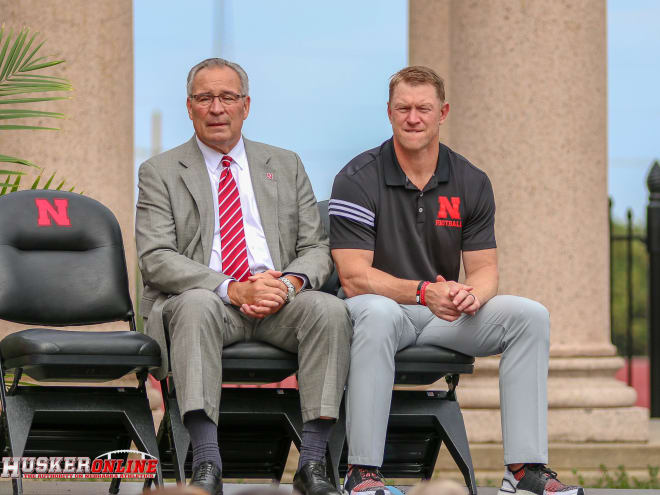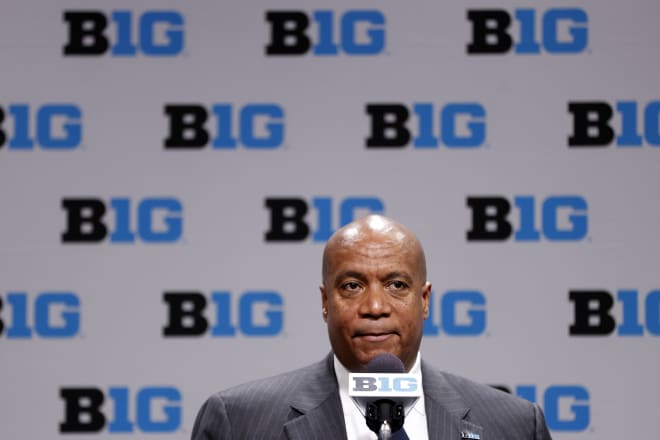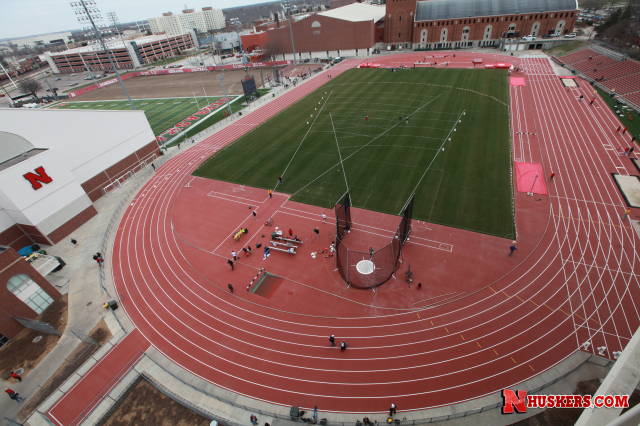Big Red Business: Lost football season would hurt other sports too
When you hear athletic directors talk about football being the economic engine for all other varsity sports, here is how the numbers play out at Nebraska:
*$59.76 million. That’s how much of an operating profit the football program generated a year ago, according to Nebraska’s latest 2019 revenue and expense report filed with the NCAA. (Men’s basketball and women’s volleyball were the other two programs out of 24 total to report more revenue than expenses.)
$-8.44 million. The combined operating deficit of the other eight men’s programs, excluding football and basketball.
*- $16.23 million. The combined operating loss for 13 of the 14 women’s sports programs.

*$10 million. The amount of money the athletic department is now transferring to the university’s general fund for scholarships to non-student athletes.
*$5.5 million. This accounts for the economic impact to the city of Lincoln for each home football game, based on an economic impact study from 2018. That doesn’t count the millions of dollars also slide into the state treasury from taxes for hotels, food, gasoline and more.
*$50 million. The size of the rounded-off check deposited in Nebraska’s bank account by the Big Ten Conference for shared media rights. This is the largest line item on the athletic department’s revenue sheet.
Such is the financial power of Nebraska football, and such might be the ripple effects if the 2020 season were reduced to nine games or seven games, or five games, or cancelled altogether.
It is difficult to predict if or when the 2020 football season will be played at this point. Nebraska’s season is scheduled to kick off in five months on Sept. 5 against Purdue at Memorial Stadium.
While some college football coaches have publicly said they expect college football to be played this fall in some scheduled fashion, it’s notable that most conference commissioners, television network executives, and athletic directors have avoided trying to predict the future at this point of the coronavirus cycle.
For the Big Ten, a key date is May 4. That’s when the current suspension of all organized team activities is scheduled to be re-evaluated again. New commissioner Kevin Warren has largely avoided any public comment since the pandemic hit the United States.
And if you really want to project into the future, the Big Ten’s football media day is still on the calendar for July 23.

Big Ten paycheck
Of course, the big elephant in the room for Nebraska and its Big Ten partners is the media rights revenue share. Conference officials have not said a word publicly whether this package will be altered, nor have the athletic directors, including Nebraska’s Bill Moos.
As HuskerOnline previously reported, Nebraska is in a better position than most schools to survive any revenue sharing cuts from the conference because it historically operates in the black and has no debt on the books.
But, hypothetically, if there was no football season and all the conference schools lost their entire $50 million revenue sharing checks, Nebraska’s operating revenue would overnight go from $136.23 million to about $86 million.
The athletic department reported total operating expenses in its 2018-2019 fiscal year that ended June 30 of $124.15 million, which would have the program staring at a deficit of about $50 million and perhaps in need of loans to balance the books.
There would be additional revenue lost from the cancellation of the NCAA men’s basketball tournament, though as HuskerOnline reported, that money only accounts for low, single-digit impact on the athletic department’s budget.
Throw out revenue from football season tickets and any declines in donations, and there’s the scenario of the world going to hell in a handbasket.
Of course, there wouldn’t be as much spending either, so the red ink would be reduced too.
But take a deep breath from this exercise in numbers. It’s not reality at this point.
As of now, Nebraska has not announced any sports spending cuts. Moos has said he is properly focused on the athletes’ well-being and on finding new revenue sources -- possibly from the sale of alcohol on football game days.
Moreover, construction is still scheduled to begin in June on the $155 million athletics training facility adjacent to Memorial Stadium, according to a timeline posted on the athletic department’s website.
In contrast, several schools in the Power Five conference as well as conference offices have recently announced budget-tightening measures. For example:
*Iowa State has announced a 10 percent salary reduction and elimination of bonuses for its coaches and athletics administrators.
*North Dakota State University’s athletic director said earlier this month that fundraising for a $37.2 million indoor football practice facility has been paused.
*The Big 12 conference has implemented a 10 percent salary cut across the board in the conference office, including for commissioner Bob Bowlsby. “We’ve eliminated all year-end bonuses and are formulating a reduced scope of operation plan that saves quite a bit of money, but we’re a relatively small operation,” he said.
*The Pac-12 also has enacted an array of cost-cutting measures, including a 20 percent salary reduction for commissioner Larry Scott, and an 8 percent reduction in the Pac-12 Network work force, according to the San Jose Mercury News.

Gap coverage
Nebraska is considered one of the few if only major college athletic departments with three sports showing operating profits: Football, with an operating profit of $59.76 million for its 2018 season; men’s basketball, at $5.87 million; and women’s volleyball at $212,061.
Where does that leave the other team sports?
To give you an idea of the importance of football revenue -- along with men’s basketball and women’s volleyball -- in paying the bills, here are the operating losses on the other men’s and women’s sports.
Data is based on Nebraska’s financial filing with the NCAA. Again, the reporting period covered July 1, 2018 to June 30, 2019. Nebraska’s financial report was filed in December 2019.
| Sport | Revenue |
|---|---|
|
Baseball |
-$1.36 million |
|
Golf |
-$793,600 |
|
Gymnastics |
-$942,351 |
|
Tennis |
-$860,815 |
|
Track & field/cross country |
-$2.89 million |
|
Wrestling |
-$1.59 million |
| Sport | Revenue |
|---|---|
|
Basketball |
-$2.75 million |
|
Bowling |
-$1.01 million |
|
Golf |
-$669,984 |
|
Gymnastics |
-$1.46 million |
|
Rifle |
-$583,862 |
|
Soccer |
-$2.02 million |
|
Softball |
-$1.85 million |
|
Swimming & Diving |
-$1.59 million |
|
Tennis |
-$799,320 |
|
Track & Field/cross country |
-$3.31 million |
|
Beach volleyball |
-$179,652 |
As you might expect, scholarships, recruiting, equipment, travel, academic support, life skills programs, the training table, medical, strength and conditioning and other costs add up quickly for each sport.
Put another way, a women’s golf athlete at Nebraska, for example, has essentially the same access to services and support as a volleyball or football player.

Starting the season
College football will return. Memorial Stadium will fill up again, red balloons will fill the sky, and there will be plenty of games on television to satisfy your demand.
When that will happen is impossible to say. But keep an eye on these developments in the pro ranks.
The PGA has said it plans to resume play in June, with no fans in attendance. Meanwhile, Major League Baseball is exploring the possibility of starting the season in Arizona, with no fans allowed and players even required to sit in the stands to adhere to social distancing. Games might be shortened to seven innings, with double-headers, and expanded rosters to support weary arms and legs.
The NBA said it will not make a decision on the future of this season before May 1.
Bowlsby, the Big 12 commissioner,has been the most visible of the Power 5 conference commissioners in addressing the status of the 2020 football season.
On Thursday, he said he remained concerned about “whether or not we can have a full and robust football season” because of the coronavirus pandemic.
He said he has been speaking with the other Power 5 conference commissioners daily.
“Virtually every program is highly reliant on football revenue,” Bowlsby told ESPN. “We’re making lots of contingency plans, but if you don’t get the anticipated number of games in, you lose the donations, you lose the sponsorships, you lose the gate receipts, and you lose the TV. It’s potentially very impactful.”
He declined to say which specific scenario the Big 12 is considering if the season has to be altered or pushed back.
A few college football coaches have been making noise about getting the season back on track.
Last week, Oklahoma State’s Mike Gundy said his goal was to return to his office by May 1, with players returning shortly after.
“We have to have a plan, and the plan is for that to start May 1,” Gundy said. “It might get back up in two weeks, I don’t know. I can’t make that call. If it does, we’ll start with the employees of this company, this building, then we’ll bring the players in slowly but surely we’ll test them all.”
Oklahoma State responded with this statement:
“Everyone wants to return to some degree of normalcy as soon as possible. As for Oklahoma State University, we will adhere to the advice of public health experts who are making informed decisions in the best interest of the citizens of our nation and state based on sound scientific data. We will also abide by the federal and state mandates as well as Big 12 guidelines. We will not compromise the health and well-being of our campus community. This virus is deadly and we will do our part at Oklahoma State to help blunt the spread.”
Steve Rosen covers the business of sports for HuskerOnline. Questions, comments, story ideas? Reach Steve at sbrosen1030@gmail.com.